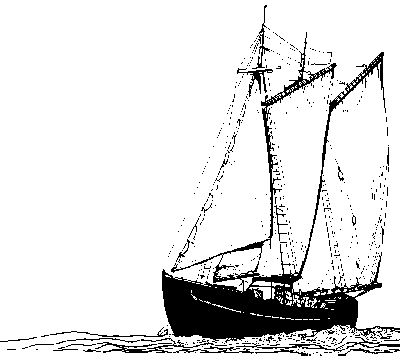
To contribute to this site, see above menu item "About".
These transcriptions may contain human errors.
As always, confirm these, as you would any other source material.
 |
He who follows history's trails in Newfoundland need not confine his interest to the Avalon Peninsula. Northward along the rockbound shores there are places and names that allure the story lover and the writer of legendary lore. There are Trinity, Catalina, Bonavista, Fogo, Twillingate and St. Anthony, all with uncommon background of historical tradition. We shall begin with the old town of Trinity, clinging to the base of Ryder's Hill and sheltered in one of the finest harbours in the world. Here in the year 1615 Sir Richard Whitbourne set up the first Court of Justice in North America. He was under orders from the British Admiralty to suppress crimes among the fishermen of European ships that came in hundreds to Newfoundland waters each summer. For several years Sir Richard carried on a successful business at Trinity and made notes for a book on Newfoundland which he subsequently published in England. A copy of Whitbourne's book was by Royal Command distributed to every parish in the kingdom. Next in turn is Catalina, the harbour of St. Catherine, visited by Jacques Cartier in 1534. In his Relation Originals, the Breton captain vividly described his ten days stay at this port, where he was delayed by field ice. He spent the time profitably in outfitting his small boats for careful navigation when he reached unknown regions within the Gulf of St. Lawrence. From Catalina he sailed to the Funk Islands to obtain food supplies from immense flocks of the Great Auk, and thence set his course for Belle Isle Strait. The harbour of Catalina today is perhaps better known by the great project and premises of the Fishermen's Union situated in the western arm. The tomb of its founder Sir William Coaker may be seen near the spacious hall and in proximity to his former home where this remarkable man of genius dominated the politics of the North. Four miles north of Cape Bonavista lies the town of that name. The cape is the landfall of John Cabot, and was designated as such on Mason's map of 1620. Mason undoubtedly knew this as a tradition among English fishermen, or he may have copied from an older chart. Bonavista is one of the oldest settlements in Newfoundland, and its founding goes back to the days of the first Fishing Admirals when those bluff traders chose the best harbours and drove the resident fishermen into more remote and less sheltered coves. Bonavista was able to muster three hundred men during the French invasion of 1696 and resisted an attempt of the enemy ships to capture the settlement. In recent years an extensive breakwater has been constructed and the harbour dredged to permit passage to large schooners and coastal steamers. Modern fish plants and long line trawlers ensure prosperity to a large fishing population who gather a prolific harvest of the sea from the rich grounds off the cape. Fogo town is on the north of Fogo Island. On the earliest maps the latter is spelled Fuego, and it is thus on the Ribeiro map of 1529. The name may have been given from some fancied resemblance to an island in the Cape Verde group, or perhaps the presence of Indian campfires inspired the visiting navigators to so name the island. The town is the oldest settlement north of Bonavista Bay, and dates back to 1680. On the east of the island is the village of Tilting to which we have previously referred. The name is a changed form of Tilt Town, and undoubtedly the later was so called from the primitive log huts of early Irish settlers. Near Tilting is Sandy Cove which was a favourite resort of the Beothuks in their annual migration to the coast. Tradition holds that a rock with red stains is the spot where a fisherman was murdered by the natives. Twillingate has been called the capital of the north. It was founded about the same time as Fogo, and has been a centre of trade for Labrador and shore fisheries for two centuries. The name is derived from the French family surname Toulinquet, and was given by early fishermen from the land of the Fleur-de-Lys. It was the birthplace of the famous operatic singer Miss Toulinquet Stirling. At Twillingate there is a fine modern hospital which serves the needs of the people of Notre Dame Bay. Both Twillingate and Fogo were used as business centres by English firms who carried on a thriving trade in these northern towns two centuries ago. Besides the fishing industries, there was a lucrative barter in seals and furs, and in the lumber which could be obtained easily in the teeming forest areas of Gander and Exploits. On the northern tip of the Great Northern Peninsula lies the town of St. Anthony, made famous by the work of that indefatigable friend of man, Dr. Wilfred Grenfell. His work is too well known to need any lengthy tribute.
|
Page contributed by: Bill Crant, April 30, 2000
Page revised: August 2002 (Terry Piercey)
Newfoundland's Grand Banks is a non-profit endeavor.
No part of this project may be reproduced in any form
for any purpose other than personal use.
JavaScript DHTML Menu Powered by Milonic
© Newfoundland's Grand Banks (1999-2025)
Hosted by
![]()
Your Community, Online!
![[Recent]](../recent.gif)
![[Contacts]](../contacts.gif)
![[Home]](../home.gif)